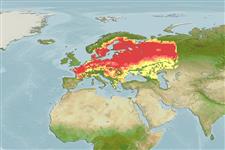Classification / Names
Common names from other countries
Main reference
Size / Weight / Age
Max length : 85.0 cm SL male/unsexed; (Ref. 59043); common length : 30.0 cm TL male/unsexed; (Ref. 556); max. published weight: 4.0 kg (Ref. 556); max. reported age: 18 years (Ref. 41616)
Length at first maturity
Lm ? range ? - ? cm
Environment
Freshwater; brackish; benthopelagic; pH range: 7.0 - 7.5; dH range: 10 - 15; potamodromous (Ref. 51243); depth range 15 - ? m (Ref. 5732)
Climate / Range
Temperate; 4°C - 20°C (Ref. 1672), preferred ?; 73°N - 37°N, 7°E - 136°E
Distribution
Europe and Asia: Baltic, Black, northern Caspian and North Sea basins, Atlantic basin southward to Seine and lower Loire drainages (France). Absent in Scandinavia north of 69°N. In Asia, eastward to Lena drainage and Aral basin. Introduced to Great Britain and northern Italy (Ref. 59043). Transported to several countries in Europe and the United States for ornament (Ref. 4537).
Countries | FAO areas | Ecosystems | Occurrences | Introductions
Short description
Dorsal
spines
(total): 3;
Dorsal
soft rays
(total): 8-11;
Anal
spines: 3;
Anal
soft rays: 8 - 11;
Vertebrae: 47. Diagnosed from congeners in Europe by the following characters: lateral line with 56-58 + 3 scales; pharyngeal teeth 3,5-5,3; mouth terminal; dorsal fin with 8½ branched rays; anal fin with 10-11½ branched rays; all fins except dorsal fin with reddish tinge; pigmentation on lateral scales lacking regular black mesh (Ref. 59043). Caudal fin with 19 rays (Ref. 2196).
IUCN Red List Status (Ref. 115185)
Threat to humans
Harmless
Human uses
Fisheries: commercial; gamefish: yes; aquarium: commercial
Tools
Special reports
Download XML
Internet sources
Estimates of some properties based on models
Phylogenetic diversity index
PD50 = 0.5000 many relatives (e.g. carps) 0.5 - 2.0 few relatives (e.g. lungfishes)
Trophic Level
3.8 ±0.59 se; Based on food items.
Resilience
Low, minimum population doubling time 4.5 - 14 years (tm=5-9)
Vulnerability
High vulnerability (63 of 100)
Price category
